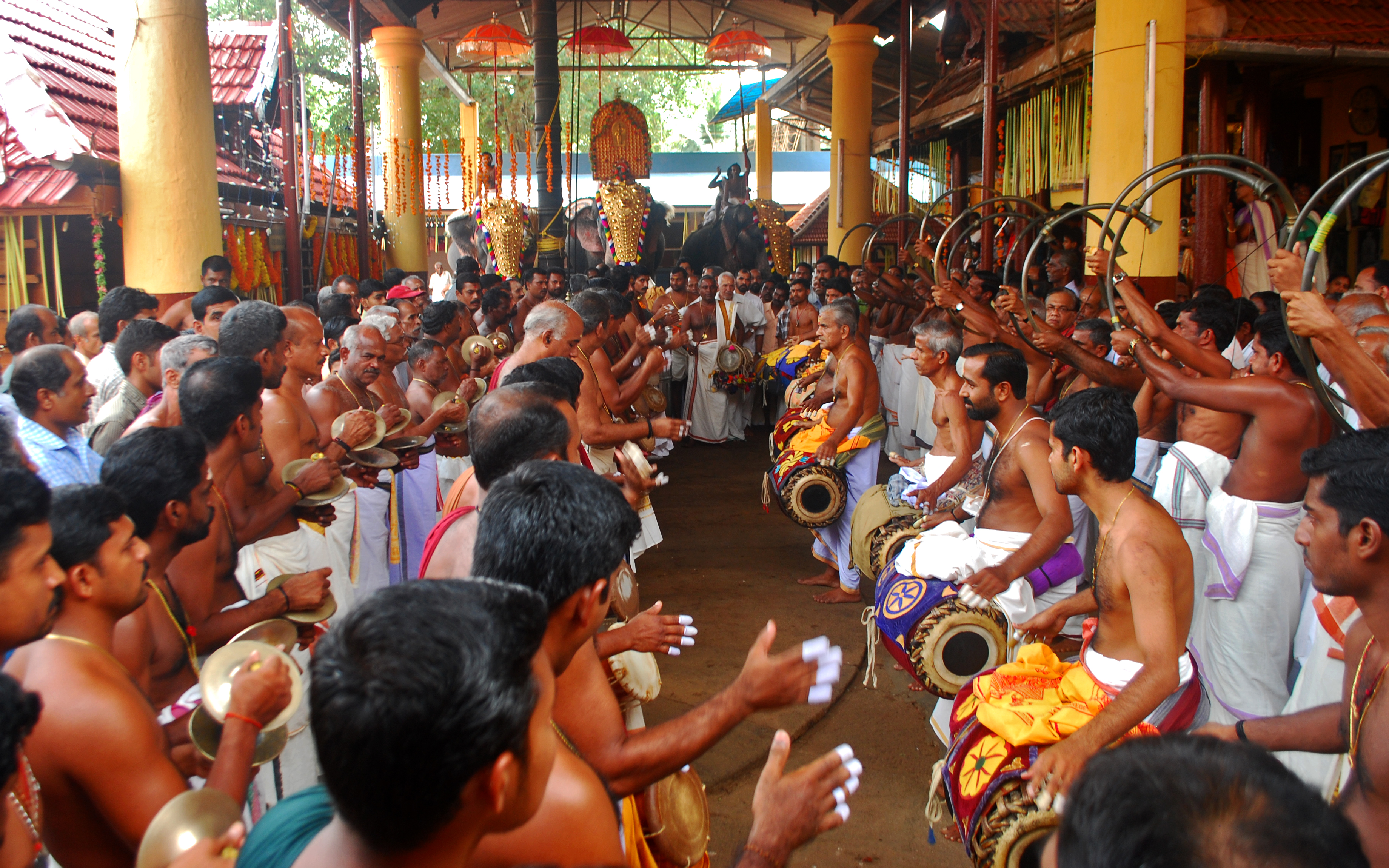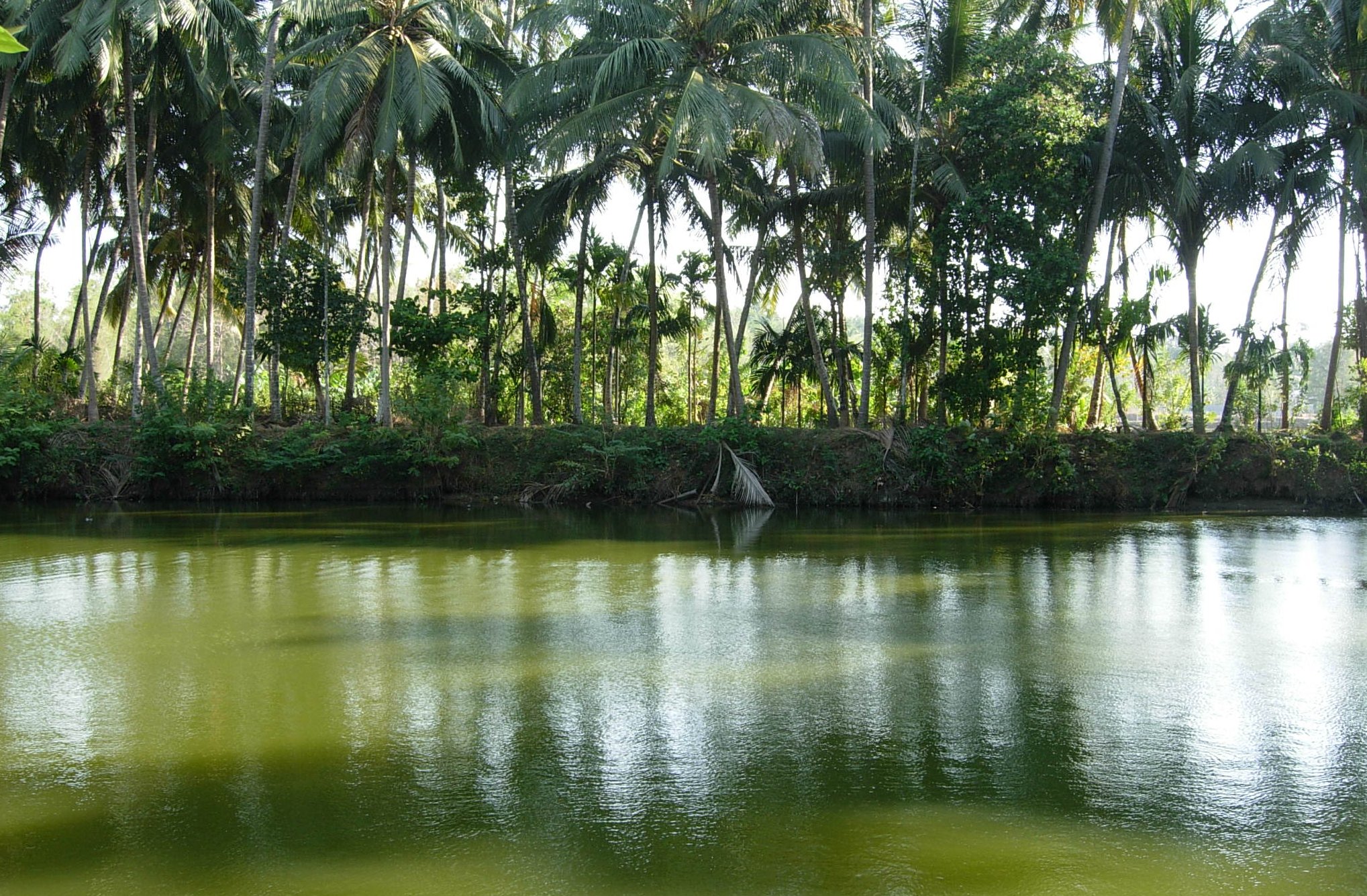|
Parayan Thullal
Parayan Thullal is a dance and poetic performance form prevailed in the state of Kerala, India. This one of the three major thullal forms prevailing in Kerala. Others are Ottan Thullal and Sheethankan Thullal. Usually, it is conducted in the morning time. The Sanskrit metre Mallika is commonly used in this art form. Performing The tempo of this art form is very slow. The performer explains the meanings of the songs by using gestures. The dance element is very little in this art form and most of the time the performer will stand erect. Usually the stories of Parayan thullal deals with spiritual matters. Costume The costume of Parayan thullal resembles Shesha. The person performing the art wears the dress and crown in the shape of snake. A red cloth is worn on the waist. The face will be adorned with yellow paint. List of some Parayan Thullals *Sabhapravesham *Thripuradahanam *Kumbhakarnavadham *Dakshayagam *Keechakavadham *Pulindeemoksham *Sundopasundopakhyanam *Nalayanic ... [...More Info...] [...Related Items...] OR: [Wikipedia] [Google] [Baidu] |
Shesha
Shesha (Sanskrit: शेष; ) , also known as Sheshanaga (Sanskrit: शेषनाग; ) or Adishesha (), is a serpentine demigod (Naga) and Nagaraja (King of all serpents), as well as a primordial being of creation in Hinduism. In the Puranas, Shesha is said to hold all the planets of the universe on his hoods and to constantly sing the glories of Vishnu from all his mouths. He is sometimes referred to as Ananta Shesha, "Endless-Shesha", or Adishesha, the "First Shesha". It is said that when Adishesa uncoils, time moves forward and creation takes place; when he coils back, the universe ceases to exist. The Narayana form of Vishnu is often depicted as resting on Shesha, accompanied by his consort Lakshmi. Adishesha is considered as one of the two mounts of Vishnu alongside Garuda. He is said to have descended upon Earth in the following human forms or incarnations: Lakshmana, brother of Vishnu's incarnation Rama during the Treta Yuga, and according to some traditions, as Bala ... [...More Info...] [...Related Items...] OR: [Wikipedia] [Google] [Baidu] |
Panchavadyam
Panchavadyam (Malayalam: പഞ്ചവാദ്യം), literally meaning an orchestra of five instruments, is basically a temple art form that has evolved in Kerala. Of the five instruments, four — timila, maddalam, ilathalam and idakka — belong to the percussion category, while the fifth, kombu, is a wind instrument. Much like any chenda melam, panchavadyam is characterised by a pyramid-like rhythmic structure with a constantly increasing tempo coupled with a proportional decrease in the number of beats in cycles. However, in contrast to a chenda melam, panchavadyam uses different instruments (though ilathalam and kompu are common to both), is not related very closely to any temple ritual and, most importantly, permits much personal improvisation while filling up the rhythmic beats on the timila, maddalam and idakka. Panchavadyam bases itself on the seven-beat thripuda (also spelt thripuda) thaalam ( taal) but amusingly sticks to the pattern of the eight-beat chempata ... [...More Info...] [...Related Items...] OR: [Wikipedia] [Google] [Baidu] |
Koodiyattam
Koodiyattam ( ml, കൂടിയാട്ടം; IAST: kūṭiyāṭṭaṁ; ) is a traditional performing art form in the state of Kerala, India. It is a combination of ancient Sanskrit theatre with elements of ''Koothu'', an ancient performing art from the Sangam era. It is officially recognised by UNESCO as a Masterpiece of the Oral and Intangible Heritage of Humanity. Origin Koodiyattam, meaning "combined acting" in Malayalam, combines Sanskrit theatre performance with elements of traditional koothu. It is traditionally performed in temple theatres known as ''koothambalams''. It is the only surviving art form that uses drama from ancient Sanskrit theatre. It has a documented history of a thousand years in Kerala, but its origins are not known. Koodiyattam and Chakyar koothu were among the dramatized dance worship services in the temples of ancient India, particularly Kerala. Both koodiyattam and Chakyar koothu originated from the ancient art form koothu, which is mention ... [...More Info...] [...Related Items...] OR: [Wikipedia] [Google] [Baidu] |
Mohiniyattam
Mohiniyattam, ( ml, മോഹിനിയാട്ടം), is an Indian classical dance form that developed and remained popular in the state of Kerala. Kathakali is another classical dance form of Kerala. Mohiniyattam dance gets its name from the word Mohini – a historical enchantress avatar of the Hindu God Vishnu, who helps the good prevail over evil by developing her feminine powers. Mohiniyattam's roots, like all classical Indian dances, are in the ''Natya Shastra'' – the ancient Hindu Sanskrit text on performance arts. However, it follows the Lasya style described in ''Natya Shastra'', that is a dance which is delicate, eros-filled and feminine. It is traditionally a solo dance performed by women after extensive training, though nowadays men can also perform the dance. The repertoire of Mohiniyattam includes music in the Carnatic style, singing and acting a play through the dance, where the recitation may be either by a separate vocalist or the dancer themselves. T ... [...More Info...] [...Related Items...] OR: [Wikipedia] [Google] [Baidu] |
Kathakali
Kathakali ( ml, കഥകളി) is a major form of classical Indian dance. It is a "story play" genre of art, but one distinguished by the elaborately colourful make-up and costumes of the traditional male actor-dancers. It is native to the Malayalam-speaking southwestern region of Kerala and is almost entirely practiced and appreciated by Malayali people. Kathakali's roots are unclear. The fully developed style of Kathakali originated around the 17th century, but its roots are in the temple and folk arts (such as Krishnanattam and religious drama of the kingdom of the Zamorin of Calicut) southwestern Indian peninsula), which are traceable to at least the 1st millennium CE. A Kathakali performance, like all classical dance arts of India, synthesizes music, vocal performers, choreography and hand and facial gestures together to express ideas. However, Kathakali differs in that it also incorporates movements from ancient Indian martial arts and athletic traditions of South Ind ... [...More Info...] [...Related Items...] OR: [Wikipedia] [Google] [Baidu] |
Chakyar Koothu
Chakyar Koothu (pronounced ) is a performance art from Kerala, India. It is primarily a type of highly refined monologue where the performer narrates episodes from Hindu epics (such as the ''Ramayana'' and the ''Mahabharata'') and stories from the Puranas. Sometimes, however, it is also a traditional equivalent of the modern stand-up comedy act, incorporating commentary on current socio-political events (and personal comments directed at the members of the audience). The performance "Koothu" means dance ... which is a misnomer, as facial expressions are emphasized and there is minimal choreography. It is performed in the Koothambalam; a place inside Hindu temples specifically designed for performing Kutiyattam and Chakyar Koothu. Ideally, the performance takes place in conjunction with festivals, presented by members of the Chakyar community along with the Ambalavasi Nambiars. It is a solo performance, by a narrator in a distinctive headgear and black moustache with his to ... [...More Info...] [...Related Items...] OR: [Wikipedia] [Google] [Baidu] |
Mani Madhava Chakyar
Guru Mani Madhava Chakyar (IAST: ''Māṇi Mādhava Cākyār'') (15 February 1899 – 14 January 1990) was a celebrated master performance artist and Sanskrit scholar from Kerala, India, considered to be the greatest Chakyar Koothu and Koodiyattam (ancient Sanskrit drama theatre tradition) artist and authority of modern times. He was considered as the authority of '' Abhinaya'' (the classical Indian acting style) and ''Nātyaśāstra''. Known as "the Emperor of Rasa-Abhinaya", he had an exceptional ability to perform ''Rasa-Abhinaya''. His ''Netrābhinaya'' was world-famous and he had the ability to act only with eyes. He was well versed in all the traditional Koodiyattams and all the ''prabandhas'' used in Chakyar Koothu. He was able to explain the concepts, methods and practices of Koodiyattam and Chakyar Koothu in a clear and authentic way. He had an in depth study of ''Nātyaśāstra'' of Bharata Muni, as well as ways of acting which were popular in Kerala. His knowledg ... [...More Info...] [...Related Items...] OR: [Wikipedia] [Google] [Baidu] |
Killikkurussimangalam
Killikkurussimangalam (also known as Lakkidi) is a village around 8 km from nearby town Ottappalam in Palakkad district of Kerala, south India. The river Nila ( Bharatapuzha) flows through the southern border of Lakkidi. Etymology The village got its name from the famous Lord Shiva temple- Sri Killikkurussi Mahadeva Kshetram situated in the village. The temple is very old and legends say it has been founded by the sage ''Sree Suka Brahma Hrishi''. Kunchan Nambiar's birthplace The village is the birthplace of famous Malayalam satire poet and founder of the Ottamthullal art form, Kunchan Nambiar (Rama panivada). The house where Kunchan Nambiar was born, Kalakkathu Bhavanam, is now a cultural centre, undertaken by Department of Culture of Kerala State Government. There is also a library situated there in memory of Kunchan Nambiar called ''Kunchan Smaraka Vayanasala'' - Kunchan Memorial Library. Koodiyattam and Chakyar koothu artist and noted Natyashasthra scholar Nātyāchārya ... [...More Info...] [...Related Items...] OR: [Wikipedia] [Google] [Baidu] |
Arts Of Kerala
The Indian state Kerala is well known for its diverse forms of performing arts. The various communities in Kerala contribute to its rich and colourful culture.The most important traditional art forms of Kerala are Kathakali, Kalaripayattu, Koodiyattam, Theyyam, Mohiniyattam, Thullal, Padayani, Pulikali, Thiruvathirakali, Chakyarkoothu,kalaripayattu etc. Performing arts of Kerala Kerala Hindu Arts * Ayyappan Vilakku * Shastham Paatu * Kathakali * Chakyar Koothu * Nangiar Koothu * Mohiniyattam * ThirayattamThirayattam, Moorkkanad Peethambaran, Kerala bhasha Institute, TVM, * Padayani * Thiyyattu * Koodiyattam * Kerala Natanam * Panchavadyam * Thullal * Tholpavakoothu * Ottamthullal * Garudan Thookkam * Kolam Thullal * Kakkarissi Nadakam * Poorakkali * Mudiyett * Kummattikali * Kuthiyottam * Thiriyuzhichil * Kalaripayattu * Mangalamkali * Marathukali * Malayikuthu * Mukkanchathan * Charadupinnikkali * Kothammuriyattam * Sopanam * Thacholikali * Sarpam Thullal * Pulluv ... [...More Info...] [...Related Items...] OR: [Wikipedia] [Google] [Baidu] |
The Times Of India
''The Times of India'', also known by its abbreviation ''TOI'', is an Indian English-language daily newspaper and digital news media owned and managed by The Times Group. It is the third-largest newspaper in India by circulation and largest selling English-language daily in the world. It is the oldest English-language newspaper in India, and the second-oldest Indian newspaper still in circulation, with its first edition published in 1838. It is nicknamed as "The Old Lady of Bori Bunder", and is an Indian " newspaper of record". Near the beginning of the 20th century, Lord Curzon, the Viceroy of India, called ''TOI'' "the leading paper in Asia". In 1991, the BBC ranked ''TOI'' among the world's six best newspapers. It is owned and published by Bennett, Coleman & Co. Ltd. (B.C.C.L.), which is owned by the Sahu Jain family. In the Brand Trust Report India study 2019, ''TOI'' was rated as the most trusted English newspaper in India. Reuters rated ''TOI'' as India's most trus ... [...More Info...] [...Related Items...] OR: [Wikipedia] [Google] [Baidu] |
Kerala
Kerala ( ; ) is a state on the Malabar Coast of India. It was formed on 1 November 1956, following the passage of the States Reorganisation Act, by combining Malayalam-speaking regions of the erstwhile regions of Cochin, Malabar, South Canara, and Thiruvithamkoor. Spread over , Kerala is the 21st largest Indian state by area. It is bordered by Karnataka to the north and northeast, Tamil Nadu to the east and south, and the Lakshadweep Sea to the west. With 33 million inhabitants as per the 2011 census, Kerala is the 13th-largest Indian state by population. It is divided into 14 districts with the capital being Thiruvananthapuram. Malayalam is the most widely spoken language and is also the official language of the state. The Chera dynasty was the first prominent kingdom based in Kerala. The Ay kingdom in the deep south and the Ezhimala kingdom in the north formed the other kingdoms in the early years of the Common Era (CE). The region had been a prominent spic ... [...More Info...] [...Related Items...] OR: [Wikipedia] [Google] [Baidu] |






